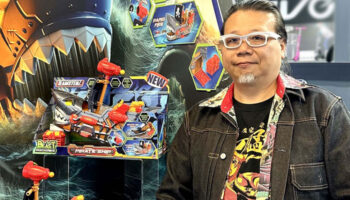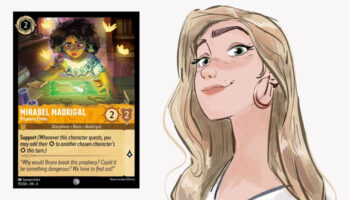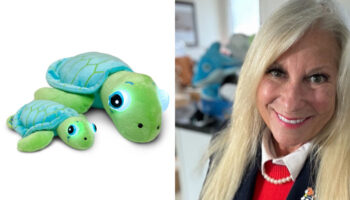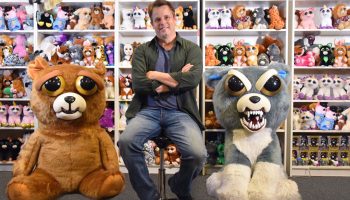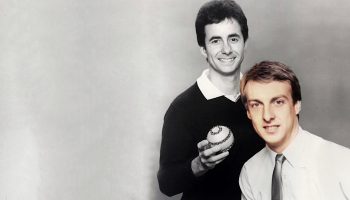“We wanted to lean into the insight that it just feels good to be bad!”: Inside the making of Clue Conspiracy

Clue Conspiracy inventor Tommy Maranges and Hasbro Gaming’s own Joe Bradford discuss bringing a hidden role twist to the classic title.
Joe, Tommy, a huge thanks for taking time out to chat about Clue Conspiracy. This adult version of the classic game introduces a hidden role element… How did this all come about?
Joe Bradford, Principal Designer, Hasbro Gaming: In 2022, after our update of the classic Clue, we were looking for new ways to expand the brand reach with an older audience. We conducted a study on the core consumer and gaming trends – seeing a resurgence of murder mysteries in pop culture – and identified gameplay mechanics such as secret roles, misdirection and social deduction as an excellent way for Clue Conspiracy to stand out on its own… These also level up what Clue is so well-known for: thrilling storytelling, high-stakes deduction and mind games. When we decided to expand into this more adult-focused version of the game, we wanted to lean into the insight that it just feels “good to be bad.”

Brilliant. And how did this bring you to Tommy?
JB: We sought out a partnership with some of the world’s best-known inventors and game designers; known for their success in mystery games and social deduction. There were many fantastic games to choose from, but we ultimately partnered with Tommy Maranges who submitted the initial idea for what Clue Conspiracy would become.
Tommy, this feels like a good time to bring you in! Before we explore your Clue concept, how did you find your way into game design?
Tommy Maranges, Game Designer & Writer: Like everything I’ve ever been successful at, it’s something I started doing as a way to procrastinate from the thing I was “supposed” to be doing. In this case, I was trying to finish out a Kickstarter project for a book that I self-published.
My friends and I were playing a lot of Avalon at the time, and in a group full of creatives of various stripes, it was hard not to wonder what made a game like that tick. Curiosity took over and we started tinkering with index cards and borrowed components and playtests. Once we had a theme, the first game came together really quickly.
I also want to acknowledge that I was very lucky to know other game designers who liked my writing. They really helped to accelerate the process of introducing me to the broader community and of solving the production problems that are easy to find vexing as a designer.

Great stuff. Now, can you talk us through a bit of your invention process for Clue Conspiracy? How did the idea take shape?
TM: Well, process is a strong word for anything I’ve ever done, but there was a ton of iterative brainstorming. I have a huge pile of linked text notes where I really tried to explore outward, and then I would try to bring it all together into a draft, and then explore outward from there, and so on… Letting that be a messy process works for me.
The process started around the second holiday season of the pandemic, so for various reasons it was hard to get people together. It took like three weeks of working on the thing before I had a playtest, and in that playtest I discovered that I had crammed basically every idea I had into this prototype. It was way too bloated. So the major lesson there was to playtest much sooner rather than remaining in abstract design space. Abstraction and theory comes easily to me as someone with a philosophy background, and I have to push myself out of there.
But seriously, just looking back through my notes, they’re a mess! They don’t really tell a very coherent story or process. Just as birds don’t make very good ornithologists, I’m not sure I understand how I did it either. A thing I’m getting better at is – when I feel stuck – stepping back and just asking “why do I feel stuck?” and then going for a long walk to come up with something different to try.
I think I needed to figure out what was even happening in this game before I could spend much time on mechanics. If I get a good “what”, then the “how” usually comes together fairly quickly.

Joe mentioned that Hasbro reached out to designers that had enjoyed success in the social deduction space, and you have tremendous pedigree here having co-created Secret Hitler and Inhuman Conditions – both brilliant games. What’s key to getting this kind of game right?
TM: That’s very kind of you to say. An experience I had growing up in Florida is trying desperately to convince someone that I’m good and they should trust me, only to discover that it was never about me in the first place and that I was wrong to trust them. So social deduction maybe comes more easily to me than other genres.
I think it’s important for me to have clarity about the kind of emotional experience I’m trying to create – and then thoughtful, attentive playtesting and an openness to starting over. A thing that happens a lot in playtesting is players will discover something that gives them a lot of information. They’ll say: “Aha! Once I get this answer, I’ll know all this other stuff.” And that’s great because I, as the designer, can just go in and cut the heart right out of that information web for the next iteration until there’s just the right amount left.
Smart!
TM: The other thing is to think about information as a kind of currency or resource, just like money or mana or time. In a social deduction game, information is the main thing players are after – and the game is in forcing them to make interesting choices to get it. Maybe information is expensive because we have to spend a whole turn gathering it; maybe it’s risky because – as in Avalon – if the bad guys find out we have it, they can punish us… Maybe if I don’t use it now, I might lose it. Force players to explore the tension between deciding too quickly and hesitating too long.
Great insights.
TM: Also, having a couple of conniving, awful playtesters to find the crevices and corner cases is a great idea! People who love nothing more than breaking your game are worth their weight in gold as playtesters, and even more so for social deduction.

Were there elements from your previous games that shaped what you pitched in for Clue Conspiracy?
TM: I think I saved a lot of time by knowing that I needed to figure out the story I was modelling before I could jump into the model. A social deduction game is usually forward-looking – you’re trying to prevent something from happening – but core Clue is backward-looking; you’re trying to figure out what already happened… I had to find a way to marry those.
I went looking for a situation that had the same sense of ‘a few strong moves’ to it as Clue, but that retained some openness to the outcome. Once I had the idea to set it on a private island and let an incoming storm be the ‘ticking clock’, things moved more quickly because I had both something that had already happened – a plot and some booby traps – and some space for players to affect how that resolved.

Joe, coming back to you for a moment, what about Tommy’s concept appealed to the internal Games team?
JB: It perfectly matched our vision by incorporating the classic Clue formula with a fresh twist, leading to a heated and thrilling gameplay experience.
Did it evolve much once taken in-house?
JB: The in-house development was a journey of refining, balancing and brand building, ensuring the game was engaging for various player counts and that its narrative and design complemented our core Clue refresh.
We had the challenging task of shaping a story to be a standalone sequel that both honoured and expanded the classic Clue story – along with a new cast of characters – and brought a sophisticated visual identity to the game experience; one that also helped facilitate the higher complexity gameplay.

Yes, plot-wise, this is very different to normal Clue. Tommy mentioned the new private island setting. For anyone that hasn’t played the game yet, can you talk us through this fresh take?
JB: Building onto our refreshed Clue characters, we stepped outside of Tudor Mansion and deeper into the glittering and deadly world of Clue. Players who dare to enter the Black Adder Resort on its secluded island find that Boddy Black’s treachery runs far deeper than just one fatal night of blackmail and murder. And, of course, they meet his associate – Callan Coral – as well as other new faces in the line-up of unscrupulous suspects…
Nicely pitched! What goes into the story-building side of a game like this? What steers the plot and how you create new characters?
JB: Crafting the plot for Clue Conspiracy was like writing a new chapter in an epic saga. Developing these new characters and story was a careful but exciting balancing act. We achieved this by taking what we already knew from the updated classic and taking it one step further.
As it pertained to character creation, the tagline of Clue – ‘One is guilty, none are innocent’ – was a key tenet to keep in mind. All the new characters in Clue Conspiracy are people with something to hide and the privilege to back it up. The new plot and setting were crafted with the goal of pushing Clue to a place that lets us expand the brand’s potential for more stories, more stunning locations, more ways to play and more mysteries players will be dying to solve.

On that, how do you gauge pushing the limits of the brand? What’s the key to bending things without breaking them?
JB: Finding that sweet spot between innovation and tradition is more art than science. Our approach was to listen – to our playtesters, fans and our own team’s instincts. It’s about respecting what makes Clue such an iconic brand, while daring to take it somewhere new. If our internal team is excited to playtest a game over and over, we know we’re onto something special.
Were there any creative challenges on this project that you’re proud to have cracked?
JB: A significant achievement was maintaining the game’s renowned ‘Rule of 3’.
The Rule of 3 being…
JB: The classic Clue solve involving a person, weapon and location. We had to incorporate these into the gameplay, despite its very different mechanics from the original Clue game. Accomplishing gameplay balance for a range of four to 10 players was challenging, but very rewarding. It couldn’t have been done without the extensive help from our internal and FunLab teams, who helped us find passionate playtesters, who led dozens and dozens of gameplay sessions to extensively test the game at each player count.

Additionally, we dedicated a considerable amount of effort to reinvent the game instructions and onboarding process, acknowledging that Clue Conspiracy’s gameplay deviates from traditional expectations.
Tommy, I wanted to ask, what makes Clue an exciting brand to invent for?
TM: My brother-in-law is an improviser, and one of the things that I’ve learned from him is that it’s better to make a few strong moves early on than to try to creep up on a scene with a bunch of small, weak moves. And Clue makes a couple of incredibly strong moves, right away.
There’s so little we know for sure: a mansion, a corpse, these suspects… But it’s enough to motivate the game. Everything that isn’t strictly necessary – motive, history, the web of relationships – is left out… Or else the flavour we are given – there’s a Colonel and also a Professor, why are they hanging out? – raises more questions than it answers. That’s really exciting to play with because you have these really, really strong, suggestive archetypes and lots and lots of room around them to fill in.
Those are much more interesting creative fodder, I think, than something that had a lot of little facts about it and none of them really seemed to matter or be more important than anything else.

Does that ring true for what makes it fun to design for internally at Hasbro Joe?
JB: Yes, Clue is a treasure trove of storytelling potential. Its rich narrative history, iconic characters and global appeal provide a canvas that’s both familiar and ripe for innovation. Mechanically, we try to maintain the constraint of the Rule of 3 – it’s what makes a Clue mystery unique and endlessly referenced in pop culture!
We think this DNA makes Clue the perfect mystery brand and we hope to continue to expand beyond the classic game; weaving in new, compelling and surprising experiences for players of all ages.
One final question for you Tommy, what fuels your creativity? What helps you have ideas?
TM: Well, it’s not like my subject matter is wildly inventive; WWII and “what if robots” are both pretty widely-explored territory! That said, allowing myself to follow my curiosity and ask about the aspects of those systems that I personally find interesting or curious has been really fruitful for me.
Sometimes constraints are really helpful, but I think they’re just a subset of decisions. Sometimes when I’m stuck, I just need to decide on a direction and try it for a bit. If I’m wrong, as I often am, I learn a lot more about why I was wrong.
Guys, this has been fascinating. A huge thanks again for taking time out to talk.
–
To stay in the loop with the latest news, interviews and features from the world of toy and game design, sign up to our weekly newsletter here





